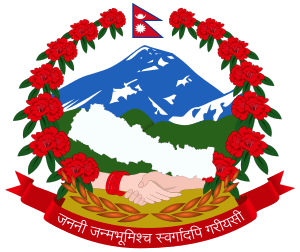Federalism in Nepal
federalism is derived from the French word fédéralisme.
Federalism in Nepal is the decentralized multi-level political system of Nepal. It replaces the monarchy held by the Shah dynasty.[1][2] Schedule 4 of the new Constitution of Nepal, adopted on 20 September 2015, drawn a line of federalism in Nepal.[3]
History
In the aftermath of the 2007 People's Revolt II, the 240 years of monarchy was abolished in the 5th amendment of the Interim Constitution of Nepal, 2063.[4][5] The amendment was the first document to mention Nepal officially as the Federal Democratic Republic of Nepal. It envisioned federalism as a prominent feature for a new Nepal.[6]
The Maoist party was the catalyst for bringing forth federalism and inclusion. Other major parties that supported the move include the Communist Party of Nepal (Unified Marxist–Leninist) and the Nepali Congress, whereas the Rastriya Prajatantra Party, which was only able to enter the parliament under the Proportional Representation scheme, has come out in opposition to the prospect of federalism as well bringing back the monarchy and declaring Nepal as a Hindu nation.[7][8][9]
Nepal had been practicing a unitary form of the government under the Shah rulers (Prithivi Narayan Shah). However this system was unable to support development of the country and was seen as an "exclusive" form of rule.[10]
Legislative Power
The power of the Provinces and the Federal government are defined by the constitution.
See also
References
- ↑ "Shah dynasty: Glory days to sorry state". thehimalayantimes.com. Himalayan Times. 28 May 2008. Retrieved 11 December 2017.
- ↑ "Nepali Politics: Then & Now". whittakerassociates.com. 30 September 2017. Retrieved 11 December 2017.
- ↑ Kathmandu Post (2017). "744 new local units come into effect". Kantipur Publications Pvt. Ltd.
- ↑ "Nepal: From revolution to revolt". reliefweb.int. 16 January 2007. Retrieved 11 December 2017.
- ↑ "After 240 Years of Monarchy, Nepal Is on a Challenging Path Towards". muftah.org. 2 January 2017. Retrieved 11 December 2017.
- ↑ "Nepal embarks on journey towards federal destiny". thehimalayantimes.com. 21 September 2015. Retrieved 11 December 2017.
- ↑ "The rise of Maoists in Nepali politics: from 'people's war' to democratic politics". eastasiaforum.org. 15 March 2013. Retrieved 11 December 2017.
- ↑ "The Nepali Congress Manifesto: Highlights". nepaldemocracy.org. Retrieved 11 December 2017.
- ↑ "Nepal poll watchdog removes 'Hindu state, monarchy' from Rastriya Prajatantra Party". financialexpress.com. 18 March 2017. Retrieved 11 December 2017.
- ↑ "Federal or Unitary ?". everestuncensored.org. Retrieved 11 December 2017.
